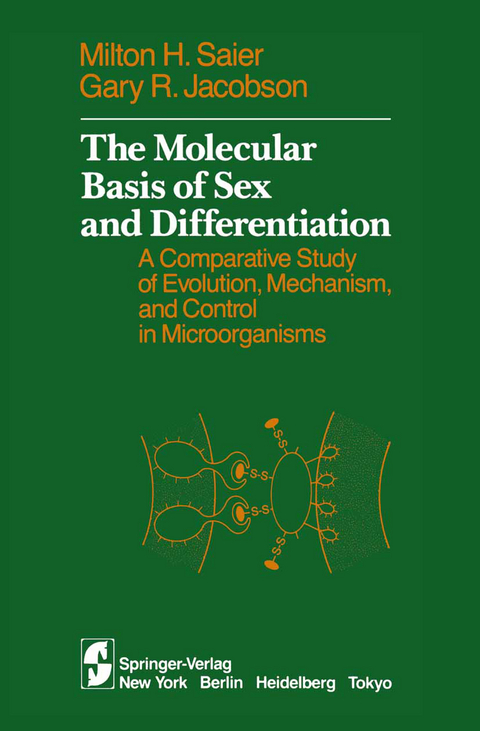
The Molecular Basis of Sex and Differentiation
Springer-Verlag New York Inc.
978-0-387-96007-4 (ISBN)
1
Embryology and the Study of Microbial Development.- 2
Molecular Events Accompanying Morphogenesis.- Cell-Cycle Dependent Morphogenesis in Caulobacter.- Control of Vegetative Morphogenesis in Neurospora.- Ion Currents Associated with Morphogenesis in Brown Algae.- The Generation and Roles of Ion Currents in Development.- Selected References.- 3
Cellular Mortality, Growth Regulation, and the Phenomenon of Cancerous Transformation.- Evolution of Multicellularity.- Two Fundamental Types of Cancerous Transformation.- Teratocarcinogenesis—Reversible Malignancy.- Transformation of Normal Somatic Cells.- Selected References.- Chapte 4
Sporulation in Evolutionary Divergent Prokaryotes and Eukaryotes.- Sporulation in Bacillus.- Bacterial Endospore Germination.- Ascospore Formation in Yeast.- Conidiation in Streptomyces and Neurospora.- Fruiting in Myxobacteria and Dictyostelium.- Selected References.- 5
Control of Spatial Differentiation by Chemical Morphogens.- Spatial Control of Fruiting Body Formation in Dictyostelium.- Heterocyst Development in Blue-Green Bacteria (Anabaena).- The Temporal Program for Heterocyst Formation.- Spatial Regulation of Heterocyst Development.- Control of Morphogenesis in Hydra.- Selected References.- 6
Transmembrane Transport and the Control of Bioelectrical Activities.- Classification of Transport Systems in Bacteria.- Solute Facilitators.- Chemically Driven Active Transport.- Group Translocation Catalyzed by the Bacterial Phosphotransferase System.- Regulation of Transport Function by the Membrane Potential and the Control of Bioelectric Activity.- Evolution of Interrelated Metabolic Enzymes, Transport Proteins, Membrane Receptors, and Regulatory Proteins.- Selected References.- 7
Cell Surface Receptors, Second Messengers, and the Control ofCellular Activities.- Mechanisms of Inter- and Intracellular Signal Transmission.- Control of Carbohydrate Catabolic Enzyme Synthesis by Intracellular Inducer and Cyclic AMP.- Coordinate Regulation of Adenylate Cyclase and Inducer Uptake by the Phosphotransferase System.- Induction of Protein Synthesis by Extracellular Inducers.- Selected References.- 8 Mechanisms of Chemoreception, Electrical Signal Transduction, and Biological Response.- Bacterial Chemotaxis: A Model of Sensation, Regulation, and Adaptation.- Bacterial Chemoreceptors.- The Avoidance Reaction of Paramecium.- Ion Channels and Behavioral Mutants in Paramecium.- Chemotactic Control of Behavior in Dictyostelium discoideum.- Selected References.- 9
Pheromone-Mediated Control of Sexual Activity.- Control of Bacterial Conjugation by Sex Pheromones.- Pheromone Control of Yeast Mating.- Pheromone Control of Sexual Activities in Insects.- Genetic Dissection of Courtship Behavior in Drosophila.- Selected References.- 10
Cellular Recognition: Mechanisms and Consequences of Homotypic and Heterotypic Adhesions.- t Loci in Mice: Components of a Genetic Program for Embryonic Development.- Cellular Recognition and Tissue Formation.- Sexual Agglutination in Yeast.- Developmental Control of Cellular Cohesion in Dictyostelium discoideum.- Heterotypic Adhesion of Bacterial Viruses to Their Hosts and Phage-Mediated Receptor Conversion.- Cell-Cell Contact as a Signal for Induction of Tissue-Specific Protein Biosynthesis.- Contact Inhibition of Fibroblast Growth.- Sea Urchin Egg Fertilization.- Selected References.- 11
Switch Mechanisms Regulating Gene Expression.- Epigenetics in Animal Cells Maintained in Tissue Culture.- DNA Methylation and the Control of Gene Expression in Animal Cells.- Paramutation in Plants.- Transposable Elements in Plants Controlling Gene Expression and Mutation Rate.- Switch Mechanisms in Microorganisms.- Biphasic Flagellar Phase Variation in Salmonella.- Inversion of the G Segment in Phage Mu.- Invertible and Transposable Elements in Differentiation.- Selected References.- 12
Sex Determination and the Interconversion of Mating Type.- Sex Determination in Yeast.- Mating Type Interconversion in Yeast.- Pattern Control of Mating Type Switching.- Sex Determination in Drosophila.- Sexual Interconversion in Higher Plants and Animals.- Selected References.- 13
Genetic Control of Development, Mating Type Determination, and Programmed Death in Ciliated Protozoa.- Genetics of Paramecium and Tetrahymena.- Control of Gene Expression in Ciliates.- Mating Type Determination in Ciliates.- Irreversible Mating Type Determination by DNA Excision.- DNA Excision in Immunoglobulin Synthesis.- Aging and Programmed Death in Ciliates.- Selected References.- 14
Conclusions and Perspectives.- Index 209.
| Zusatzinfo | 44 Illustrations, black and white; 216 p. 44 illus. |
|---|---|
| Verlagsort | New York, NY |
| Sprache | englisch |
| Maße | 155 x 235 mm |
| Themenwelt | Naturwissenschaften ► Biologie ► Biochemie |
| Naturwissenschaften ► Biologie ► Botanik | |
| Naturwissenschaften ► Biologie ► Evolution | |
| Naturwissenschaften ► Biologie ► Genetik / Molekularbiologie | |
| Naturwissenschaften ► Biologie ► Mikrobiologie / Immunologie | |
| Naturwissenschaften ► Biologie ► Zellbiologie | |
| Naturwissenschaften ► Biologie ► Zoologie | |
| ISBN-10 | 0-387-96007-4 / 0387960074 |
| ISBN-13 | 978-0-387-96007-4 / 9780387960074 |
| Zustand | Neuware |
| Haben Sie eine Frage zum Produkt? |
aus dem Bereich


